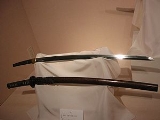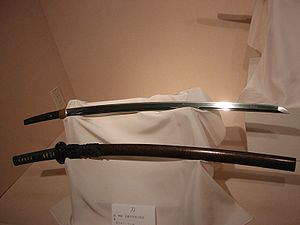
Uchigatana
Encyclopedia

Samurai
is the term for the military nobility of pre-industrial Japan. According to translator William Scott Wilson: "In Chinese, the character 侍 was originally a verb meaning to wait upon or accompany a person in the upper ranks of society, and this is also true of the original term in Japanese, saburau...
class of feudal Japan. The uchigatana was the descendant of the tachi
Tachi
The is one type of traditional Japanese sword worn by the samurai class of feudal Japan.-History and description:With a few exceptions katana and tachi can be distinguished from each other if signed, by the location of the signature on the tang...
.
History
From the HeianHeian period
The is the last division of classical Japanese history, running from 794 to 1185. The period is named after the capital city of Heian-kyō, or modern Kyōto. It is the period in Japanese history when Buddhism, Taoism and other Chinese influences were at their height...
to the Muromachi Period
Muromachi period
The is a division of Japanese history running from approximately 1336 to 1573. The period marks the governance of the Muromachi or Ashikaga shogunate, which was officially established in 1338 by the first Muromachi shogun, Ashikaga Takauji, two years after the brief Kemmu restoration of imperial...
, the primary battlefield sword was the tachi
Tachi
The is one type of traditional Japanese sword worn by the samurai class of feudal Japan.-History and description:With a few exceptions katana and tachi can be distinguished from each other if signed, by the location of the signature on the tang...
. Its long blade and sharp edge made it ideal for use on horseback. During the twelfth century uchigatana started to be used and by the Muromachi Period
Muromachi period
The is a division of Japanese history running from approximately 1336 to 1573. The period marks the governance of the Muromachi or Ashikaga shogunate, which was officially established in 1338 by the first Muromachi shogun, Ashikaga Takauji, two years after the brief Kemmu restoration of imperial...
approximately 1336 to 1573 the uchigatana began to rival the tachi as the sword of choice by samurai warriors.The word uchigatana can be found in literary works as early as the Kamakura Period
Kamakura period
The is a period of Japanese history that marks the governance by the Kamakura Shogunate, officially established in 1192 in Kamakura by the first shogun Minamoto no Yoritomo....
, but during that time the uchigatana was used only by individuals of low status and privates in the ranks.
Most uchigatana made during the early Kamakura Period
Kamakura period
The is a period of Japanese history that marks the governance by the Kamakura Shogunate, officially established in 1192 in Kamakura by the first shogun Minamoto no Yoritomo....
were not of the highest standard, and because they were considered disposable, virtually no examples from these early times exist today. It was not until the Muromachi Period
Muromachi period
The is a division of Japanese history running from approximately 1336 to 1573. The period marks the governance of the Muromachi or Ashikaga shogunate, which was officially established in 1338 by the first Muromachi shogun, Ashikaga Takauji, two years after the brief Kemmu restoration of imperial...
(considered by some to be a kind of Dark Age in the history of the Japanese Sword), when the samurai
Samurai
is the term for the military nobility of pre-industrial Japan. According to translator William Scott Wilson: "In Chinese, the character 侍 was originally a verb meaning to wait upon or accompany a person in the upper ranks of society, and this is also true of the original term in Japanese, saburau...
began to use uchigatana to supplement the longer tachi, that uchigatana of high quality began to be made. Between the Momoyama period and the Edo Period
Edo period
The , or , is a division of Japanese history which was ruled by the shoguns of the Tokugawa family, running from 1603 to 1868. The political entity of this period was the Tokugawa shogunate....
, the tachi was almost totally abandoned and the custom of wearing a pair of long and short uchigatana together, (the daisho)
Daisho
The is a Japanese term for a matched pair of traditionally made Japanese swords worn by the samurai class in feudal Japan.-Description:...
(literally “big-little”) became the dominant symbol of the Samurai class.
Description
The length of the uchigatana during the 1500s is said to be from 60cm to no more than 70cm, with a stout sugata, a steep saki-zori, and it could be used as a one handed sword due to its thin kasane and short nakago (tang) making it relatively light.As opposed to the tachi
Tachi
The is one type of traditional Japanese sword worn by the samurai class of feudal Japan.-History and description:With a few exceptions katana and tachi can be distinguished from each other if signed, by the location of the signature on the tang...
the uchigatana was worn edge-up in the belt, this and usually being slightly smaller than the tachi was the main difference between the tachi and the uchigatana. Since the uchigatana is worn differently than the tachi, the signature (mei) carved into the tang (nakago) of the uchigatana is also opposite to the tachi mei, making the words still upright instead of upside down as when one wears the tachi in the manner of the uchigatana.
Uchigatana became popular for several reasons, the uchigatana was more convenient to wear and did not get in the way of using a polearm as much as a tachi, also the frequency of battles fought on foot and the need for speed on the battlefield, were major reasons for the uchigatana being rapidly accepted and indicated that battlefield combat had grown in intensity. Since the uchigatana was shorter than the tachi, it could be used in more confined quarters, such as inside a building.
Use
Unlike the tachi, with which the acts of drawing and striking with the sword were two separate actions, unsheathing the uchigatana and cutting the enemy down with it became one smooth, lightning-fast action (this technique was called battojutsuBattojutsu
is a Japanese term meaning techniques for engaging a sword. It is often used interchangeably with the terms iaijutsu, battōdō, or iaidō, although each term does have nuances in the Japanese language and different schools of Japanese martial arts may use them to differentiate between techniques...
otherwise known as Battokiri).
The curvature of the uchigatana blade differs from the tachi in that the blade has curvature near the sword’s point (sakizori), as opposed to curvature near the sword’s hilt (koshizori) like the tachi. Because the sword is being drawn from below, the act of unsheathing became the act of striking. For a soldier on horseback, the sakizori curve of the uchigatana was essential in such a blade, since it allows the sword to come out of its sheath (saya} at the most convenient angle for executing an immediate cut.

